- +1 800 433 4609
- |
- Request Info
Electro Interstitial Scan (EIS) and Electrical Dispersion Analysis (EDA)
Indications For Use
The QBioscan System is a non-invasive bio impedance interpreter, designed for examination and screening and provides estimations for:
* Overall body composition in the age group 10 to 80 years for persons with low activity, and in the age group of 16 to 60 years for athletic subjects.
* Interstitial biochemical values. Suitable age group: 5 to 80 years.
* Physiological tissue parameters. Suitable age group is 5 to 80 years old.
* Lifestyle in terms of micro nutrition and diet. The suitable age group here is 40 to 80 years.
Further investigations with the help of the biochemical values of the interstitial fluid and through the physiological tissue parameters.
Assessment Method and Measurement Process
It is recommended to test the functions of the device before measurement, to ensure that the connection to the patient is satisfactory and hardware and software are operating properly. With the onset of measurement, a weak DC current (200 uA) is used and an imposed voltage of 1V between the six tactile electrodes that performs a sequence of successive measurements on eleven pathways of the body. Starting from anode to cathode and then from cathode to anode, the software changes the polarity for each pathway and measures the conductance of each pathway. Six electrodes are placed symmetrically on the hands, feet and forehead of the patient and a direct current of 1V is applied. For a recording of 11 segments in measurement sequence, each electrode is first in cathode and then in anode (bipolar mode), transmitting the intensity in numeric format to a program that stores the information.
A weak DC current, with the help of 6 tactile electrodes, is sending alternatively between 2 electrodes with a sequence, and a record of the electrical conductance of 11 pathways in the subject's body is displayed by the QBioscan system.
The QBioscan system is a galvanic Skin response device that provides skin conductance measurements on the PC screen in accordance with the 21 CFR 882.1540.

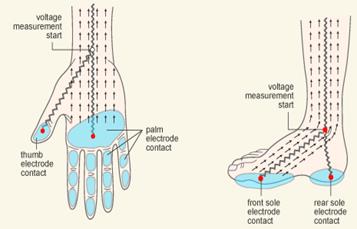
Theoretical Background
The device uses two techniques: The Bio Impedance Analysis (BIA) and the Bio Impedance Spectrometry (BIS).
The purpose of BIA is the estimation of body composition and water balance but it is also used in cardiology and imaging.
The BIS is another technique for the estimation the body composition and water balance, but it can also be used to estimate neurotransmitters.
Both techniques are based on an examination, whereby a voltage of 1V in DC (direct current) is used, that is unable to cross the cellular membranes and capillaries (High resistance in KOhms and reactance 0). It only reaches the interstitial fluid (Interstitial tissue). This is how its resistance, intensity and conductivity can then be measured. This method is based on the research of Kanai and Meijer, whose findings confirmed that cellular membrane and capillaries behave as one capacity because of dielectric properties, hence the reason why a direct current circulates solely in the interstitial fluid and is unable to penetrate its membranes. The tissues form an electrolytic environment that conducts electric current by the ionic porters that appear by the creation of tension between two electrodes. As electric current is from anode to cathode, the main ionic porters are represented in the form of sodium (higher extracellular concentration in positive charges). The volume (water content) of the space traversed Interstitial Fluid also plays a role in the conductivity.
Interstitial Fluid Sodium Concentration
The correlation of the traversed compartment intensity and the Na+ concentration is presented in the information below.
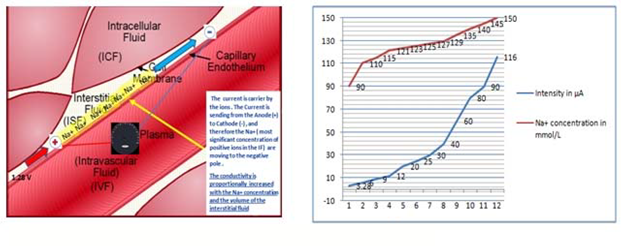
Volume (water content) and traversed compartment conductivity in correlation.
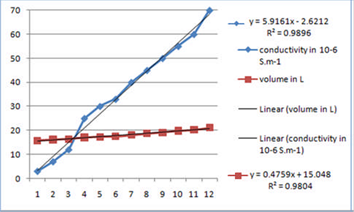
Interstitial fluid sodium intensity and concentration - Normal range
121.6 to 129 mmol/L is considered the normal range of interstitial fluid sodium concentration
Its intensity (Cottrell equation) from 12.4 to 20 uA (according to the coefficient c, the normal range can vary depending on age/gender/age/weight/age of the subject) should be corresponding.
Volume of the interstitial fluid - Normal range
The volume of interstitial fluid is related to
The total weight: normal range 16% +/- 3 of the total weight
The size of this space (inter capillary distance): 80 +/- 5 um
Estimated of Tissue Oxygen Delivery
Estimated oxygen delivery in correlation to the inter-capillary distance
This figure demonstrates the effect of inter capillary distance variations (interstitial fluid volume) that are present in relation to the oxygen delivery of the tissue. Oxygen delivery is reduced once there is an increased interstitial volume.
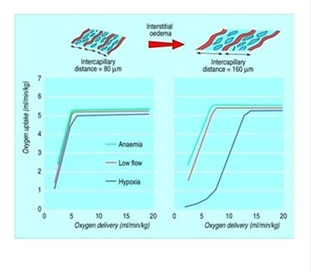
Observing Bio impedance and oxygen and estimated oxygen delivery and its correlation to resistance
To determine its patho-physiological evolution, a living tissue's electrical impedance can be continuously evaluated. Some examples of pathologies that, because of implied cellular alterations, are indicators of impedance changes are ischemia, infarct or necrosis. That is why bioimpedance tracking and monitoring has been suggested for myocardium ischemia discovery, for graft viability assessment and for graft rejection monitoring - the alteration of the extra-intracellular volumes can be detected in most of the cases and conclusions can be drawn.
The graphic below illustrates how biomedance measurements can monitor ischemia. Throughout the normoxic condition, the extracellular spaces allow a significant amount of low frequency current to flow through. That changes with the presence of ischemia. The resulting lack of oxygen (hypoxia) prohibits the cells to produce enough energy to feed the ion pumps and as a result extracellular water penetrates into the cell. The cell grows and invades the extracellular space, which causes a reduction of the low frequency current that yields an impedance modulus increase at this low frequency. Hence, low frequency bioimpedance measurements are indicators of tissue ischemia.
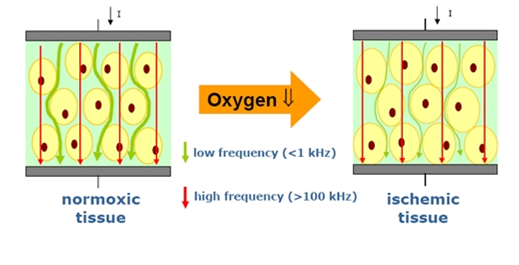
However, this oversimplified ischemia-impedance relationship description might not be accurate for cells that contain gap junctions. In such cases (for example myocardium) the discovered increase in impedance at low frequencies for the most part probably has to be attributed to the closing of the gap junctions (Gersing, 1998) (Groot, 2001).
The colored graph below for example presents the progression of the impedance module at 1 kHz. In this study, six impedance probes were inserted in a beating pig heart and subjected to regional ischemia, with three probes within the ischemia influenced area, and the other three within a normoxic area. (references in Groot, 2001).
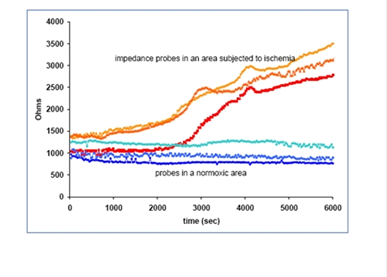
Because the loss of membrane integrity allows continuity between the extra and intra-cellular media, the necrosis process following a long-term ischemia can also be detected - the impedance magnitude at low frequencies decreases (Haemmerich et al., 2002).
Some researchers have promoted single-frequency measurements as the basis for a clinical parameter to control and monitor tissue condition. They are easily performed and as they provide the necessary information the ischemia processes can be followed. Further information and an improved reproducibility of the results, however, is provided by the Cole-Cole model - multiple frequency bioimpedance measurements (bioimpedance spectrometry) and the subsequent characterization. (Raicu et al., 2000).
Bio Impedance Spectrometry (BIS)
The QBioscan, with the help of the Spectrometry technique and in particular the Chronoamperometry, calculates and estimates the interstitial fluid ionograms and interstitial fluid H+ concentration in accordance with to the ionic flux (Diffusion coefficient of the ions)
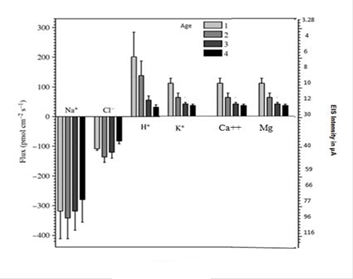
The interstitial fluid Na+ concentration provides entry to the estimated activity of: Na+/K+ ATPase
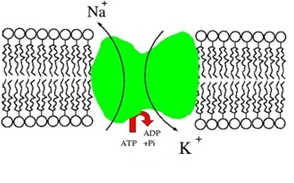
The Chronoamperometry: The Cottrell's Equation
The Cottrell equation is a formula that, in connection with chronoamperometry, measures biochemical values with weak concentrations. It is used in laboratory tests devices and for serotonin assessments.
Chronoamperometryis a technique that steps the working electrode potential abruptly from an initial to a final potential, with the formal potential of the analyte generally crossing the step.
The solution is left unstirred with the initial potential, ensuring that there is no flow of current (holding the electrode at a potential that allows for neither oxidation nor reduction of the predominant form of the analyte). Following that, the potential is stepped to a potential that either oxidizes or reduces the analyte, and as a result, current begins to flow at the electrode. Quite large at first, it quickly decays as the analyte near the electrode is consumed, and a transient signal is observed.
If the point in time when the potential is stepped is taken as time zero, then the Cottrell equation describes the how the current, I, decays as a function of time, t:
Cottrell equation and formula of the mathematical transformation that calculates the QBioscan system's concentration

F = Faraday constant (96500 C/mole)
A = Electrode area (en cm2)
Co = Ionic concentration (mol/ cm3)
n = number of electrons per molecule
D = Diffusion coefficient (cm2/ s)
t = Measurement time in seconds
The current decreases as the reciprocal of the square root of time, despite the fact that (in the case of adsorbed redox species) the decrease might come across as exponential. This dependence on the square root of time demonstrates the fact that the responsibility for transport of the analyte to the electrode surface is physical diffusion.
Interstitial Fluid PH and Its Effect In Human Body
The tissue pH (normal range is between 7.31 to 7.35) or interstitial fluid influences the enzyme activities and has therefore also action in the pancreas and liver function.
The tissue pH (normal range is between 7.28 to7.32 or cerebral interstitial fluid is active in the blood flow of the brain and neuronal excitability.
Electrode Polarization Impedance (EPI)
The ratio of the electrolyte bulk resistance and polarization impedance is called polarization ratio.
Regardless of electrode material, the polarization ratio diminishes as a function of concentration in diluted Na/Cl solutions. Compared to other electrodes, the data for the medical stainless steel behaved concentration independent and it had high electrode polarization impedance.
General Contraindications
* The QBioscan cannot be used in combination with cardiac peacemakers or any other implanted electronic devices, with or in the presence of defibrillators, or in patients connected to electronic life support devices.
* In patients that are unable to sit or be held upright
* Electrodes will not perform properly with dermatological lesions
* An absence of one or more limbs.
* Excessive perspiration (hyperhidrosis)
* With extremities or joints carrying prostheses or metal pins
* Pregnant women cannot be exposed to this device, as possible effects on the fetus are unknown and the accuracy of the readings in such conditions is not clear.
* The QBioscan System is sensitive to geopathic electromagnetic discharges due to the low voltage signals it generates, and therefore requires a supportive location. The ground (synthetic material) and relative humidity < 30% can prevent accurate measurements.
KEY_Web_Disclaimer
